Labour market report, March 2022
Employment in Ontario increased by 35,100 in March. Get the details in this report.
Quick facts
In March 2022:
- There were 12.5 million people in Ontario aged 15 years or older
- 8.2 million (65.4%) were in the labour force. The labour force increased in March (13,500 or 0.2%) compared to February.
- 7.7 million (61.9%) were employed, up by 35,100 (0.5%) from February.
- Ontario's unemployment rate fell to a more than two year low of 5.3% in March from 5.5% in February and 429,800 people were unemployed, down 4.8% (21,600) from February.
Important note:
This report is based on the Labour Force Survey (LFS), a household survey carried out by Statistics Canada. March’s LFS results cover labour market conditions during the week of March 13 to 19.
The March LFS reflects the easing of public health measures in Ontario that began on March 1, 2022, including lifting capacity limits and proof of vaccination requirements for all settings.
Employment increased in March
Employment in Ontario increased in March by 35,100 (0.5%), after increasing by 194,300 (2.6%) in February.
Ontario employment (7,722,900) was above its pre-pandemic level by 228,300 (3.0%) with March’s increase. Employed remained higher than the pre-pandemic level for the second consecutive month.
Chart 1 shows employment in Ontario from January 2005 to March 2022.
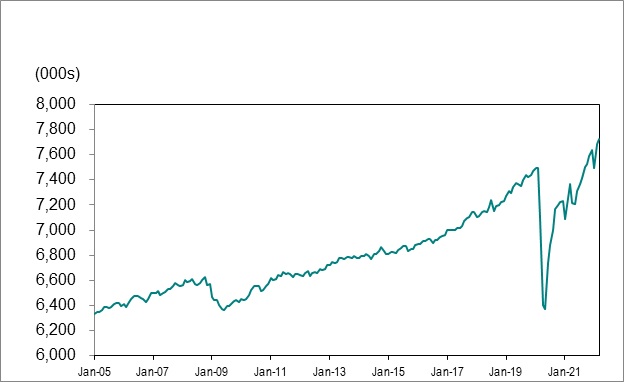
Source: Statistics Canada, Labour Force Survey, Table 14-10-0287-01, (seasonally adjusted data).
Full-time vs. part-time
Full-time jobs accounted for all of March’s job gains, increasing by 65,500 (1.0%) positions. Part-time jobs decreased by 30,400 (-2.2%) in March.
Employment change by sex and age
March’s employment increase was 20,700 (0.5%) for men and 14,400 (0.4%) for women. Employment among men was 3.7% (146,900) above its pre-COVID February 2020 level. Employment among women was 2.3% (81,300) above, continuing its growth from February after falling below its pre-COVID February 2020 level in January.
Youth (ages 15-24) employment increased by 4,000 (0.4%) in March, after increasing by 85,300 (9.2%) in February. Employment for people aged 25 to 54 increased by 13,500 (0.3%) in March, following an increase of 93,700 (1.9%) in February. Employment for those aged 55 and older increased by 17,600 (1.0%), after increasing by 15,400 (0.9%) in February.
In March, youth employment was 0.2% (-2,400) below its pre-COVID February 2020 level, but has made significant gains since January when it was 9.0% below its pre-pandemic level. Employment among those aged 25-54 was 4.5% (216,600) above, while employment among older workers (those aged 55 and older) rose above its February 2020 level for the first time since March 2021 (up 0.8% or 14,100).
Employment in Canada increased by 72,500 (0.4%) in March after increasing by 336,600 (1.8%) in February.
Employment change by industry
The government’s restrictions and health measures aimed at addressing the impact of COVID‑19, as well as the easing of these restrictions and measures, should be considered in the context of employment change by sector.
Construction (11,200 or 1.9%), manufacturing (8,800 or 1.1%), other services, except public administration (7,900 or 3.2%) and professional, scientific and technical services (7,500 or 0.9%) led job gains in March. There were notable employment losses in transportation and warehousing (-13,000 or -3.3%) and accommodation and food services (-8,000 or -2.0%).
In March, eleven of the sixteen major industry groups had employment levels that were above pre-COVID February 2020 levels, led by professional, scientific and technical services (128,200 or 19.1%), finance, insurance, real estate, rental and leasing (59,800 or 9.9%), wholesale and retail trade (47,700 or 4.3%), construction (34,400 or 6.1%) and information, culture, recreation and sport (33,700 or 11.2%).
Employment in accommodation and food services (-60,100 or -13.5%) was furthest below its pre-COVID February 2020 level, followed by other services, except public administration (-47,800 or -15.6%), business, building and other services (-32,200 or -9.8%) and transportation and warehousing (-17,000 or -4.3%).
Chart 2 shows industries by employment change in Ontario, February 2022 to March 2022.
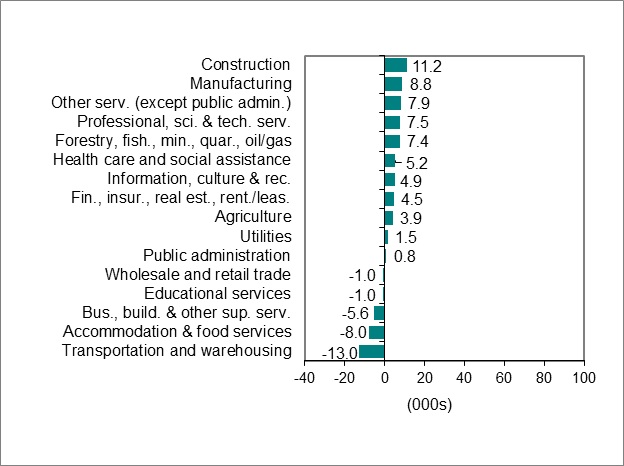
Source: Statistics Canada, Labour Force Survey, Table 14-10-0355-02, (seasonally adjusted data).
Unemployment rate decreased to 5.3%
Chart 3 shows unemployment rates, Ontario and Canada, January 2005 to March 2022.
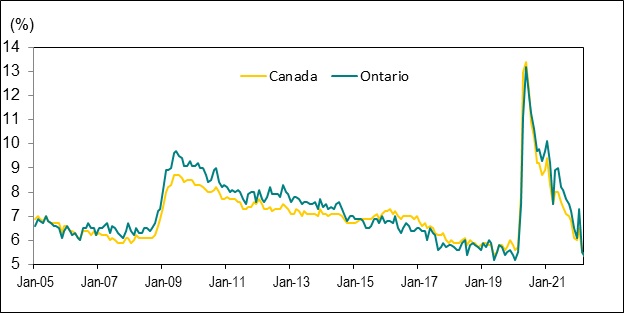
Source: Statistics Canada, Labour Force Survey, Table 14-10-0287-01, (seasonally adjusted data).
Ontario’s unemployment rate was 5.3% in March, slightly below the February 2020 pre-pandemic rate (5.5%) and the lowest recorded rate since January 2020 (5.2%). The unemployment rate was 5.5% in February.
Canada’s unemployment rate was 5.3% in March, below its February 2020 pre-pandemic rate of 5.7% for the second consecutive month. Canada’s unemployment rate was 5.5% in February. March’s unemployment rate was at its lowest level since comparable data became available in 1976.
Unemployment rate by sex, age and visible minority status
The unemployment rate for women rose to 6.1% in March, above the February 2020 pre-pandemic rate of 5.6%. It was 5.7% in February. The rate for men decreased to 4.5%, falling below the February 2020 pre-pandemic rate of 5.4% for the first time since the pandemic. It was 5.4% in February.
For individuals aged 15 to 24, the unemployment rate fell to 10.4% in March from 12.2% in February. The youth unemployment rate was 11.3% in February 2020 and reached a record high of 29.5% in May 2020.
The unemployment rate for individuals aged 25 to 54 rose to 4.7% in March, slightly above its February 2020 pre-pandemic rate of 4.6%. The rate for this cohort was 4.4% in February.
The unemployment rate for those aged 55 and older decreased to 3.5% from 4.5% in February, below its February 2020 pre-pandemic rate of 4.1% for the first time since the pandemic.
In Ontario, the unemployment rate among population groups designated as visible minorities was estimated at 7.7% in March in comparison to a 5.5% rate for non-visible minorities and those that did not identify as Indigenous (data are for the population aged 15 to 69 and are not adjusted for seasonality).
Long-term unemployment
In March, an average of 86,200 Ontarians or 20.1% of all unemployed people were unemployed for 27 weeks or longer (long-term unemployed). This compared to 80,700 or 17.9% of all unemployed people in February and was also higher than the pre-COVID February 2020 level of 71,000. Although the total number of unemployed people in Ontario fell in March, the number of long-term unemployed increased from the previous month for the first time since September 2021 when it reached 173,400.
The average time in unemployment was 21.7 weeks in March 2022 compared to 16.0 weeks in February 2020.
Chart 4 shows the number of people unemployed for 27 week or more in Ontario, March 2005 to March 2022.
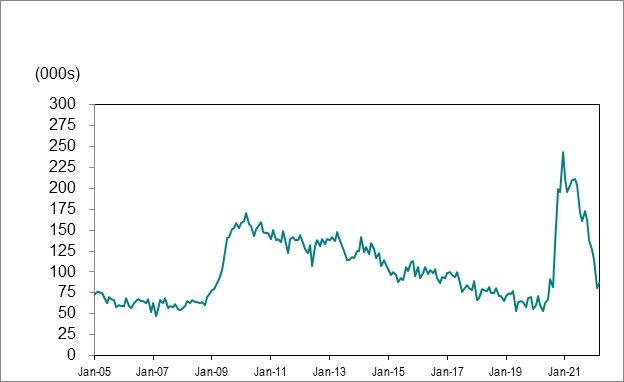
Source: Statistics Canada, Labour Force Survey, Table 14-10-0342-01, (seasonally adjusted data).
Employment and unemployment in urban centres
Employment change in urban centres
Chart 5 shows employment change for Ontario Census Metropolitan Areas (CMAs) from March 2021 to March 2022.
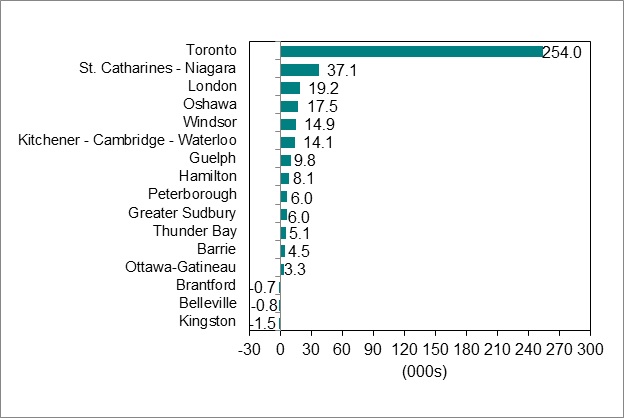
Source: Statistics Canada, Labour Force Survey, Table 14-10-0380-01, (seasonally adjusted data three-month moving average to reduce volatility caused by small sample size).
In March 2022, employment in thirteen of the sixteen Ontario Census Metropolitan Areas (CMAs) was at or above its March 2021 level, led by Toronto (254,000 or 7.7%) and followed by St. Catharines-Niagara (37,100 or 19.6%) and London (19,200 or 7.0%). The employment level fell in Kingston (-1,500 or -1.8%).
Employment in most of the 16 Ontario CMAs had reached or surpassed pre-COVID February 2020 levels in March 2022, led by Toronto (81,900 or 2.4%), London (23,300 or 8.6%) and St. Catharines-Niagara (17,100 or 8.2%).
Barrie (-14,700 or -11.4%), Belleville (-6,400 or -11.0%) and Kitchener-Cambridge-Waterloo (-3,800 or -1.1%) had employment levels that were notably below pre-COVID February 2020 levels.
Lowest and highest unemployment rates in urban centres
Chart 6 shows Census Metropolitan Areas (CMAs) with highest and lowest unemployment rates in Canada, March 2022.
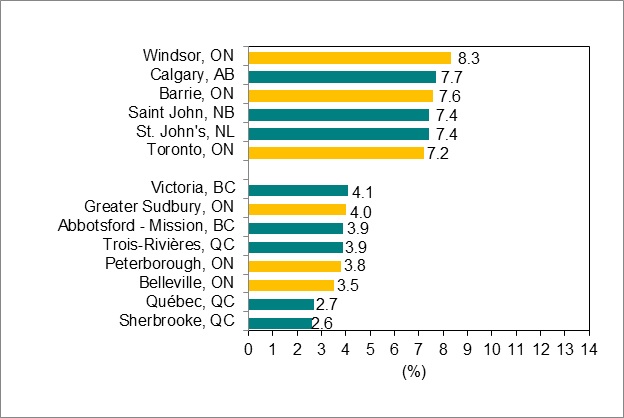
Source: Statistics Canada, Labour Force Survey, Table 14-10-0380-02, (seasonally adjusted data three-month moving average to reduce volatility caused by small sample size).
Windsor recorded the highest unemployment rate in Canada in March (8.3%), followed by Calgary, Alberta (7.7%) and Barrie (7.6%).
Sherbrooke, Quebec recorded the lowest unemployment rate in Canada in March (2.6%), followed by Québec City (2.7%) and Belleville (3.5%).
Download data
Source: Statistics Canada, Labour Force Survey
March 2022 Labour Market Report:
- CSV, Chart 1, employment in Ontario from January 2005 to March 2022, 1KB
- CSV, Chart 2, industries with highest and lowest employment change in Ontario, February 2022 to March 2022, 2KB
- CSV, Chart 3, unemployment rates, Ontario and Canada, January 2005 to March 2022, 2KB
- CSV, Chart 4, number of people unemployed for 27 week or more in Ontario, January 2005 to March 2022, 2KB
- CSV, Chart 5, employment change for Ontario Census Metropolitan Areas (CMAs) from March 2021 to March 2022, 2KB
- CSV, Chart 6, Census Metropolitan Areas (CMAs) highest and lowest unemployment rates, March 2022, 2KB